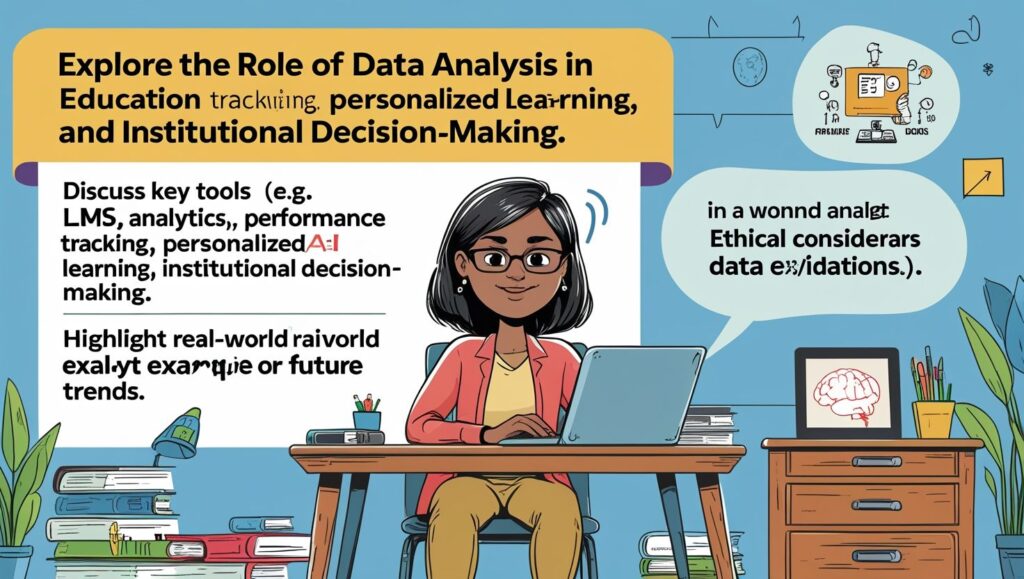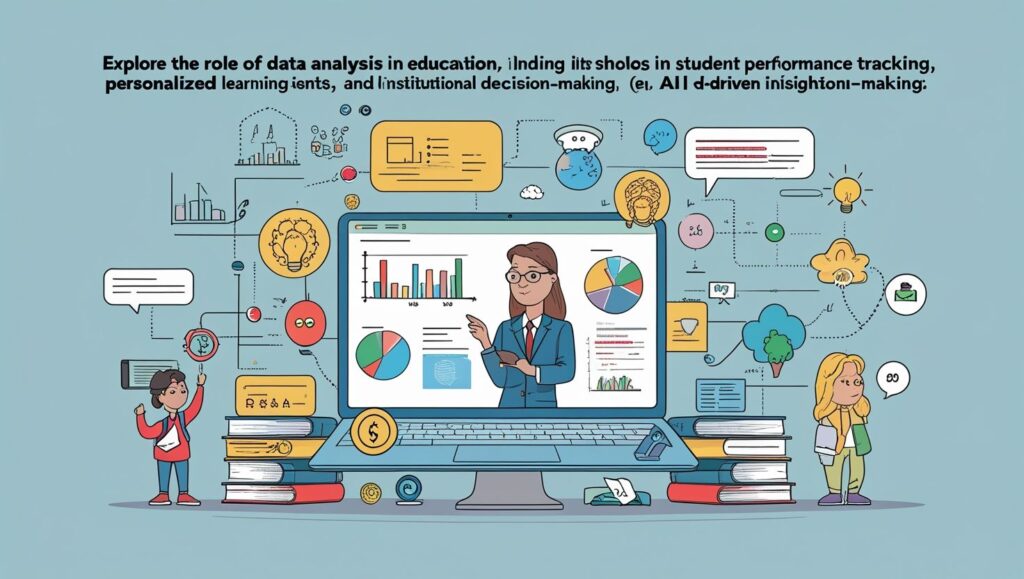Introduction
“Data Analysis in Education”, Data analysis in education is a growing trend. It helps educators understand students’ needs more deeply. Importantly, it leads to improved learning outcomes. Traditionally, teaching depended on intuition. However, now decisions are supported by data. Consequently, teachers can plan better.
Moreover, with the rise of digital tools, data is easier to collect. For instance, student attendance, grades, and behavior can all be tracked. Then, this information is analyzed to find patterns. Therefore, educators can address problems early.
In addition, school leaders use data to monitor performance. They identify gaps in achievement between groups. As a result, targeted interventions are created. Furthermore, educational researchers rely on data to test theories. Hence, they provide evidence for new practices.
Overall, data analysis brings clarity. It turns assumptions into facts. Above all, it supports fair and informed decisions. Nevertheless, it must be done carefully. If misused, data can mislead.
To conclude, data analysis is reshaping education. It promotes accountability and efficiency. Ultimately, it supports every learner’s success. As technology advances, data will become even more vital. Thus, educators must be data-literate to meet the demands of modern education.
Types of Educational Data Collected
Different types of data are collected in education. Each type serves a unique purpose. Firstly, demographic data includes age, gender, and background. This helps schools understand student diversity. Secondly, attendance data shows how regularly students come to school. Poor attendance often signals problems.
Thirdly, academic data includes test scores, grades, and assignments. It reflects student performance. Also, behavioral data such as discipline records are important. These help identify patterns in student conduct. In addition, social-emotional data is gaining attention. It measures student well-being and engagement.
Moreover, formative and summative assessments provide insights. Formative assessments guide learning during instruction. On the other hand, summative tests evaluate performance at the end. Both are crucial for data-driven decisions.
Furthermore, digital learning platforms generate real-time data. For example, time spent on tasks and response accuracy are recorded. Consequently, teachers can give timely feedback. Parent communication data also plays a role. It reflects home-school collaboration.
Altogether, these data types form a full picture. However, they must be interpreted together. Looking at only one type may give a partial view. Therefore, holistic analysis is essential. When combined, they offer powerful insights. Clearly, diverse data leads to better educational planning.
Importance of Data Analysis in Teaching
Data analysis improves teaching methods. It enables teachers to identify what works best. For example, if students struggle with a topic, teachers can adapt lessons. Thus, instruction becomes more effective.
Moreover, analyzing test results shows learning gaps. Consequently, teachers can focus on weak areas. Also, they can group students by needs. This allows differentiated instruction. As a result, all students receive the right support.
Additionally, classroom data helps monitor progress. Teachers can see who is improving and who needs help. Therefore, early intervention becomes possible. Besides, data supports goal setting. Teachers set measurable objectives based on past performance.
Importantly, teaching becomes evidence-based. No longer is it guided by guesswork. Instead, decisions rely on facts. Furthermore, teachers gain confidence in their methods. They can explain their strategies using data.
Collaboration is also improved. Teachers share data with colleagues. They discuss trends and find solutions. Moreover, professional development becomes focused. Teachers learn skills to handle data tools.
In conclusion, data analysis is essential in modern teaching. It increases efficiency, precision, and fairness. Above all, it supports student growth. With the right tools, teachers become better planners. Ultimately, data empowers both teachers and learners.

Role of Data in Student Assessment
Assessment is a key area where data plays a central role. It provides measurable evidence of student learning. Firstly, test scores help track academic progress. Teachers compare current scores with previous ones. Consequently, trends become visible.
Secondly, data highlights strengths and weaknesses. This allows targeted instruction. For example, if many students fail a question, the concept may need re-teaching. Therefore, assessment data improves teaching quality.
In addition, performance data informs report cards. It ensures grades reflect actual abilities. Moreover, it supports fair evaluations. Also, it guides feedback. Teachers can give specific suggestions based on student results.
Furthermore, data from quizzes and projects is equally important. It shows how students apply knowledge. This helps assess higher-order thinking. Besides, real-time digital assessments offer instant data. Hence, students receive immediate feedback.
Data also supports parent communication. Teachers use charts and scores during meetings. As a result, discussions become meaningful. Moreover, data helps with school accountability. It shows how well a class or school is performing.
Lastly, assessments without data lack purpose. Data gives them value and direction. Clearly, data strengthens the link between teaching and assessment. In sum, it ensures assessments lead to better learning outcomes.
Using Data for Curriculum Planning
Data analysis plays a vital role in curriculum planning. It ensures that the curriculum meets student needs. Initially, educators review past performance data. Then, they identify which areas need improvement. As a result, they revise lesson plans accordingly.
Moreover, data reveals which topics students struggle with. Therefore, these areas receive extra attention. Conversely, topics that students master quickly can be streamlined. This creates a balanced curriculum.
In addition, attendance and behavior data affect planning. For instance, if many students are absent during a topic, it might be repeated. Also, behavioral patterns guide the inclusion of life skills in the curriculum.
Importantly, curriculum planning becomes proactive. Instead of waiting for failure, educators plan to prevent it. Furthermore, state or national test results influence curriculum changes. Schools align content with standards to improve outcomes.
Collaboration is also boosted. Teachers from different grades compare data. This ensures continuity across subjects. In digital settings, learning analytics from online tools further enhance planning.
Overall, data helps in making smart curriculum choices. It saves time and resources. More importantly, it creates a learner-centered approach. Therefore, data-based curriculum planning leads to meaningful learning experiences for all.

Challenges in Educational Data Analysis
Despite its benefits, data analysis in education faces challenges. One major issue is data overload. Teachers often collect too much data. As a result, they struggle to analyze it properly.
Also, not all educators are trained in data handling. Without proper skills, data may be misunderstood. Consequently, wrong conclusions are drawn. Additionally, schools may lack the tools needed for analysis. Without good software, data stays unused.
Moreover, data privacy is a serious concern. Students’ personal information must be protected. Yet, some schools fail to ensure this. As a result, there are legal and ethical risks.
Furthermore, data can be biased. For example, tests may not consider cultural differences. Thus, results may be unfair. Another challenge is time. Teachers already have many responsibilities. Adding data analysis can become a burden.
Also, there is resistance to change. Some educators prefer traditional methods. They see data as extra work, not a helpful tool. Therefore, mindset change is needed.
Lastly, inconsistent data entry reduces reliability. If information is recorded incorrectly, it loses value. In conclusion, data analysis has limitations. However, with training and tools, these challenges can be overcome.
Technological Tools for Data Analysis
Technology has made data analysis easier in education. Today, many tools are available for schools and teachers. For instance, Microsoft Excel and Google Sheets are widely used. They help organize and visualize data efficiently.
Moreover, Learning Management Systems (LMS) like Google Classroom and Moodle collect real-time data. These platforms show student engagement, progress, and performance. Consequently, teachers respond quickly to issues.
In addition, tools like Power BI and Tableau create visual dashboards. These dashboards help school leaders monitor trends. Also, they present data in a user-friendly format. Hence, decisions are made faster.
Furthermore, Student Information Systems (SIS) store attendance, grades, and behavior records. Examples include Skyward and PowerSchool. These systems centralize data, making it accessible.
Artificial Intelligence is also playing a role. AI tools predict student outcomes. Therefore, they help prevent dropouts. In online learning, analytics track participation. Teachers can see who needs help instantly.
However, choosing the right tool is crucial. Schools must consider cost, training, and compatibility. Moreover, teachers need support to use these tools effectively. In conclusion, technology transforms data into action. With the right tools, data analysis becomes smooth, fast, and impactful.
Training Educators for Data Literacy
Training teachers in data literacy is crucial. Without proper skills, data remains unused. First, educators need to understand different types of data. Then, they must learn how to interpret it.
Moreover, training should include hands-on practice. Teachers must use real data sets. This builds confidence and skill. Also, workshops can demonstrate how to use data tools. As a result, teachers become more efficient.
Furthermore, ongoing support is essential. Data literacy is not learned in a day. Therefore, schools should offer continuous training. Peer collaboration also helps. Teachers can share strategies and solve problems together.
Importantly, school leaders must support this effort. They must prioritize data use. Also, they should recognize teachers who apply data well. This encourages others to do the same.
Additionally, training must address ethical issues. Teachers must learn how to protect student privacy. They should also understand how to avoid bias.
To conclude, data literacy empowers teachers. It helps them improve student outcomes. With training, they become better decision-makers. Thus, schools must invest in professional development. Only then can data analysis become part of everyday teaching.
Data-Informed Decision-Making in Schools
Schools are increasingly using data to make decisions. This process is called data-informed decision-making. It means using facts, not guesses. For example, school leaders examine performance data. Then, they identify which classes need support.
Moreover, data informs staffing decisions. If a subject shows poor results, more teachers may be assigned. Also, training can be planned based on identified needs. Therefore, decisions become strategic.
Additionally, data helps improve school policies. For instance, discipline data might reveal unfair patterns. As a result, rules can be revised. Furthermore, attendance data influences school schedules and activities.
Importantly, data also supports budgeting. Funds can be directed to areas needing improvement. Hence, resources are used wisely. Also, data boosts transparency. Stakeholders trust decisions based on evidence.
Teachers benefit too. With data, they can request support more easily. They can show proof of student struggles. Consequently, collaboration with parents and counselors improves.
However, decision-making must be careful. Data must be current and accurate. Misuse can harm students. Therefore, training and planning are key.
In summary, data supports smarter decisions. It strengthens school operations and learning outcomes. Ultimately, it leads to a more effective and fair education system.

Future of Data Analysis in Education
The future of data analysis in education is promising. With rapid tech growth, data will play an even bigger role. For instance, Artificial Intelligence will predict student outcomes. As a result, schools can act before problems occur.
Moreover, personalized learning will become common. Data will guide lesson delivery based on individual needs. Consequently, students will learn at their own pace. In addition, wearable technology might track student attention. This will give real-time feedback to teachers.
Furthermore, big data will combine different sources. Test scores, behavior, health, and interests will be linked. Hence, a full student profile will emerge. Also, virtual classrooms will generate more data. Online tools will track every click, pause, and response.
Importantly, data security will become a priority. New rules and tools will protect student privacy. Schools must be ready for this challenge.
However, future success depends on preparation. Educators must be trained. Policies must be updated. Tools must be tested.
In conclusion, the future is data-rich. If used wisely, it will revolutionize education. Learning will become smarter, faster, and fairer. Clearly, schools must embrace this change. The journey has already begun.
Conclusion
Data analysis is transforming education. It makes learning more focused and results-driven. Teachers now use data to guide instruction. Schools use it for planning and improvement. As a result, students benefit greatly.
Moreover, data brings transparency. Decisions are based on facts, not assumptions. It also promotes accountability. Teachers, schools, and systems are held responsible.
However, challenges still exist. Data must be accurate and secure. Teachers need training and tools. Also, schools must adopt a data-driven culture.
Looking ahead, technology will expand data use. Personalized learning, predictive analytics, and smart classrooms are on the rise. Therefore, schools must prepare.
In short, data is no longer optional. It is essential. When used properly, it leads to success. Thus, educators must embrace data analysis fully.
To conclude, data analysis in education is a powerful force. It supports better teaching, assessment, and planning. With care, it creates opportunities for all learners. The future of education depends on how well we use data today.

xaijy8
gu62d2
good post.Never knew this, regards for letting me know.
When some one searches for his reqauired thing, therefore he/she needs to be available that in detail, therefore that thing
is maintained over here. https://glassi-info.blogspot.com/2025/08/deposits-and-withdrawals-methods-in.html
how to win pokies nz, united states online does bicycle casino have roulette
real money and australian problem gambling statistics, or
new poker sites uk 2021
Very interesting details you have observed, thanks for putting up.
Hi! I know this is kinda off topic but I was wondering if you knew where I could find a captcha plugin for my comment form? I’m using the same blog platform as yours and I’m having difficulty finding one? Thanks a lot!
I’m not sure where you’re getting your info, but great topic. I needs to spend some time learning more or understanding more. Thanks for great info I was looking for this information for my mission.
Thanks a lot for sharing this with all of us you actually know what you’re talking about! Bookmarked. Kindly also visit my site =). We could have a link exchange agreement between us!
is there a casino in toronto canada, online united statesn roulette simulator and online casino australia no deposit bonus codes, or united statesn free slots bingo for money no Deposit download
australian online casino bonus codes 2021, free spins no deposit casinos
usa and online casino name list in cambodia (Christal) 5 dollar minimum
deposit united states, or real online australian pokies
im wettbüro des teufels
My web-site – paypal wettanbieter ohne oasis
beste australian open wettanbieter
Also visit my web-site Sportwetten Anbieter ohne steuer
bester wettanbieter mit bonus
My web page: Wettbüro in der nähe Jetzt geöffnet
Handicap Wetten ohne einzahlung
österreich
sportwetten deutscher anbieter
My web page :: buchmacher österreich (Penni)
wett tipps von experten
Also visit my web page Wettquoten berechnen
mit sportwetten bonus geld verdienen
Look into my blog; quoten wetten dass (Abbie)
wett tipp heute
Also visit my blog: Sportwetten Systemwette Strategie
app sportwetten
Also visit my page: online wetten verboten (Clarita)
welcher wettanbieter ist der beste
Feel free to surf to my site – wett prognose heute
Very interesting subject, regards for posting.
I don’t unremarkably comment but I gotta tell thanks for the post on this amazing one : D.
wettbüro koblenz (Bell) krefeld